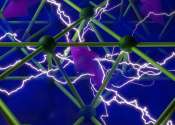In particle physics, a fermion (named after Enrico Fermi) is any particle which obeys the Fermi–Dirac statistics (and follows the Pauli exclusion principle). Fermions contrast with bosons which obey Bose–Einstein statistics.
A fermion can be an elementary particle, such as the electron; or it can be a composite particle, such as the proton. The spin-statistics theorem holds that, in any reasonable relativistic quantum field theory, particles with integer spin are bosons, while particles with half-integer spin are fermions.
In contrast to bosons, only one fermion can occupy a particular quantum state at any given time. If more than one fermion occupies the same physical space, at least one property of each fermion, such as its spin, must be different. Fermions are usually associated with matter, whereas bosons are generally force carrier particles; although in the current state of quantum physics the distinction between the two concepts is unclear.
The Standard Model recognizes two types of elementary fermions: quarks and leptons. In all, the model distinguishes 24 different fermions: 6 quarks and 6 leptons, each with a corresponding anti-particle.
Composite fermions, such as protons and neutrons, are key building blocks of matter. Weakly interacting fermions can also display bosonic behavior under extreme conditions, such as in superconductivity.









